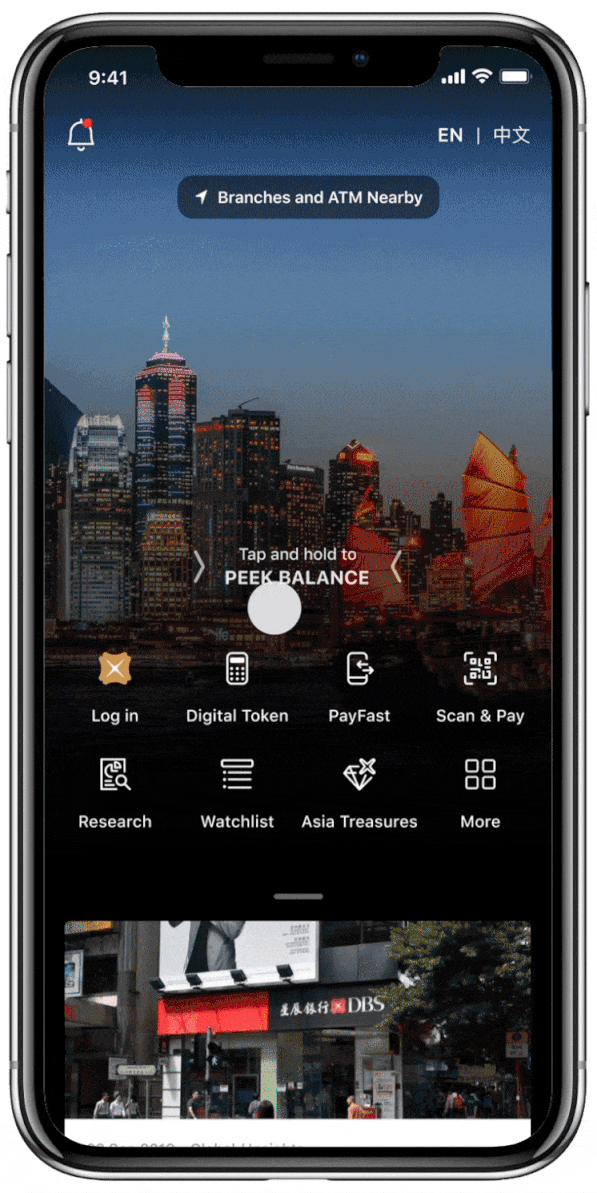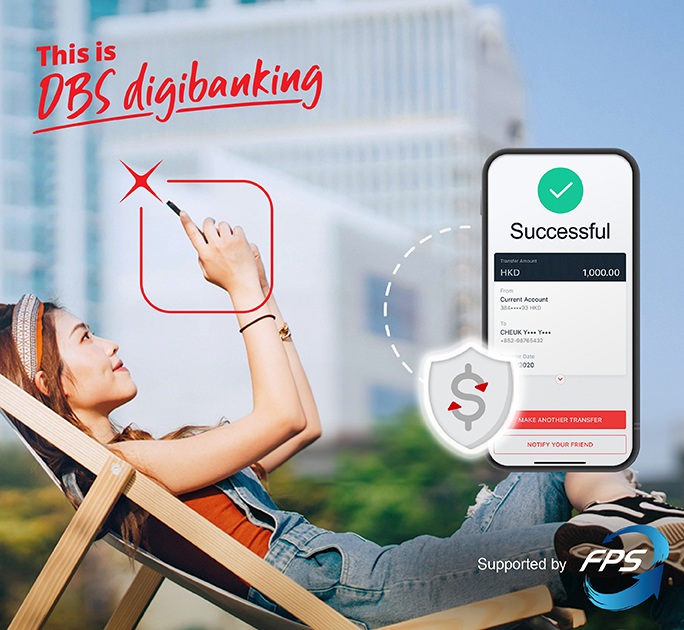eLaisee 
At a Glance |
Spread good fortune with our eLaisee service on DBS digibank HK app all year round! Powered by the Faster Payment System (FPS), our eLaisee service lets you send customisable blessings to loved ones using just their FPS-registered mobile number or email address. It’s a perfect, more eco-friendly way to express your best wishes for the New Year, birthdays, weddings and more.
Select different eLaisee packets for different occasions and enjoy double luck by sending in pairs
Customise the eLaisee amount and share the eLaisee packet image via instant messaging tools^
Send eLaisee using the recipient’s FPS-registered mobile number or email address
Secure Point-to-Point transaction – funds are transferred to payee’s FPS registered account only
Instant payment status/submission notice displayed on the transfer confirmation screen in addition to SMS and email confirmation
Remark:
The eLaisee service is supported by The Faster Payment System which is provided and operated by Hong Kong Interbank Clearing Limited. Use of eLaisee or related bank services supported by Faster Payment System is subject to terms and conditions. Please refer to the terms and conditions relating to Faster Payment System under the Bank Accounts and Services Terms and Conditions.
The exact timing of crediting funds to recipient's account will be subject to the operations of the recipient bank.
^The actual display of the eLaisee animated image shared will be subject to the operation of the messaging service provider used.
Sending eLaisee is easy and fun!
A daily limit of up to HK$10,000 is shared between PayFast, eLaisee and Scan & Pay. If the transferred amount exceeds your remaining daily transfer limit for eLaisee, we will debit the whole transaction amount from your daily transfer limit for “non-registered recipients”* to complete the eLaisee transfer. This requires authentication with your Digital Token or Secure Device.
* The maximum daily transfer limit for “non-registered recipients” for DBS Personal Banking customers, DBS Treasures customers and DBS Treasures Private Client/DBS Private Bank customers are HK$150,000, HK$300,000 and HK$600,000 respectively.
Activate transfer limit on mobile
Learn More



Click here to learn how to download the stickers.
Send eLaisee on Mobile
|
Step 1: Log in to DBS digibank HK app 1 You can toggle on the “Send in pairs” to send two eLaisees of the same amount of gift money at a time |
 |
 |
|
Step 1: Log in to DBS digibank HK app 1 You can toggle on the “Send in pairs” to send two eLaisees of the same amount of gift money at a time |
Latest Promotions:
Frequently Asked QuestionsNEW
Powered by FPS, eLaisee is a transfer service in the DBS digibank HK app which allows you to send digital "Laisees" to your family and friends. You can choose different eLaisee packets for different occasions. You can even customise the eLaisee amount and greeting message, and share the eLaisee packet image with your family and friends via instant messaging tools.^
Different customer segments and transaction types have different maximum daily transfer limits.
- Shared between PayFast, eLaisee and Scan & Pay: HK$10,000
- For non-registered recipients: HK$600,000 for DBS Treasures Private Clients/DBS Private Bank clients; HK$300,000 for DBS Treasures customers; HK$150,000 for DBS Personal Banking customers
- For registered recipients: HK$1,000,000
If the remaining daily transfer limit for PayFast, eLaisee and Scan & Pay is insufficient, we will debit the whole transaction amount from your daily transfer limit for “non-registered recipients” to complete the eLaisee transfer. Please authenticate it with your Digital Token.
Click here to find out how to activate your transfer limit.
- If I find my recipient’s FPS proxy ID/bank account number/Stored Value Facility (SVF) account number is being flagged by the high risk alert, how can I remove it?
The high risk alert is generated based on information collected from scam reports and recorded in the Scameter of the Hong Kong Police Force. Please contact them at enquiry@cyberdefender.hk if you think the FPS proxy IDs/bank account numbers/SVF account numbers are not tagged correctly or if you think there is an error with the information/alert. - Will DBS be able to help remove my FPS proxy IDs/bank account numbers/SVF account numbers from the high risk alert?
No, DBS cannot do the deletion. The high risk alert is generated based on information collected from scam reports and recorded in the Scameter of the Hong Kong Police Force. Please contact them at enquiry@cyberdefender.hk if you think the proxy IDs/account numbers are not tagged correctly or if you think there is an error with the information/alert. - If I want to report a suspicious FPS proxy ID/bank account number/SVF account number, what should I do?
The high risk alert is generated based on information collected from scam reports and recorded in the Scameter of the Hong Kong Police Force. If you suspect a crime case has occurred, please call “Anti-Scam Helpline 18222” hotline for assistance. If you suspect that you have fallen prey to a scam, please report to the Hong Kong Police Force at a police station or via Hong Kong Police Force e-Report Centre. - If there is no high risk alert message relating to my recipient, does it guarantee it is safe to transfer to him/her?
No, it is not guaranteed. The high risk alert message will only be shown if the recipient’s FPS proxy ID/bank account number/SVF account number is included in the scam reports provided by the Hong Kong Police Force. If there has not been any report to the Police against a particular FPS proxy ID/bank account number/SVF account number, the proxy ID/account number will not be included in the high risk alert.
You are advised to always verify the payment details (including the recipient’s identity) of every single transaction before making payment. - Why is my recipient’s FPS proxy ID/bank account number/SVF account number previously not tagged in the high risk alert but now being tagged?
The FPS proxy IDs/bank account number/SVF account number flagged as "High Risk" in Scameter and included in the high risk alert are based on information collected from scam reports provided by the Hong Kong Police Force. If there has not been any report to the Police against a particular FPS proxy ID/bank account number/SVF account number, the proxy ID/account number will not be included in the high risk alert. - What is the source of the high risk alert and how is my private information being protected?
The high risk alert is generated based on information collected from scam reports and recorded in the Scameter of the Hong Kong Police Force. Please visit the webpage of Scameter for more details. - Why I found my FPS proxy ID/bank account number/SVF account number on the high risk alert when doing transfer? I did not commit any crime!
According to the record provided by the Hong Kong Police Force, your FPS proxy ID/bank account number/SVF account number is related to a scam report. Please contact them at enquiry@cyberdefender.hk if you think the FPS proxy ID/bank account number/SVF account number is not tagged correctly. - I discovered my recipient's mobile number/account number has been flagged in Scameter. How come DBS did not alert me when I now try to make payment to this FPS proxy ID/bank account number/SVF account number?
The high risk alert is generated based on information collected from scam reports provided by the Hong Kong Police Force and updated from time to time on a daily basis. Please check again that the recipient is trustworthy before you proceed with the transaction. - I discovered my recipient's mobile number/account number has been flagged in Scameter. How come DBS did not alert me when I previously made payment to this FPS proxy ID/bank account number/SVF account number?
The FPS proxy ID/bank account number/SVF account number flagged as "High Risk" in Scameter and included in the high risk alert are based on information collected from scam reports provided by the Hong Kong Police Force. If there has not been any report to the Police against a particular proxy ID/account number, the proxy ID/account number will not be included in the high risk alert.
- How would I know if my recipient’s mobile number/email address/FPS Identifier/bank account number/SVF account number is flagged for high risk alert?
You can check from Scameter (cyberdefender.hk) to see if it is flagged as “High Risk”. When performing a transaction with use of FPS proxy ID (i.e. mobile number, email address, or FPS Identifier)/bank account/SVF account via DBS iBanking/ DBS digibank HK app/ DBS Card+ app/ DBS bank counter/ ATM, a high risk alert message will be displayed for those FPS proxy IDs/bank accounts/SVF accounts flagged in the scam reports provided by the Hong Kong Police Force. You are advised not to make any transactions to the recipient unless you have carefully verified the recipient’s identity and ensure that the recipient is trustworthy. - If I confirm to DBS to proceed with a transfer with FPS proxy ID (i.e. mobile number/email address/FPS Identifier)/bank account/SVF account flagged as “High Risk” and subsequently realise I have been scammed, what should I do?
If you suspect you have been scammed, you may visit a police station or the Hong Kong Police Force e-Report Centre to file a report. In tandem, please report the case to our Customer Services Hotline at (852) 2290 8888. - If a recipient’s mobile number is flagged as “High Risk”, will his/her email address/FPS Identifier/bank account number/SVF account number also be flagged by the high risk alert?
The FPS proxy IDs/bank account number/SVF account number flagged as "High Risk" in Scameter and included in the high risk alert are based on information collected from scam reports provided by the Hong Kong Police Force. If there has not been any report to the Police against a particular FPS proxy ID/account number, the proxy ID/account number will not be included in the high risk alert. - Can I confirm and accept the high risk alert message and make transfer to the FPS proxy ID/bank account number/SVF account number on the high risk alert?
Yes, you can, but please be reminded that the transaction has high risk of fraud. You are advised to always verify the payment details (including the recipient’s identity) of every single transaction before making payment.
Terms and Conditions
Terms and Conditions apply. Please refer to Faster Payment System section under Bank Accounts and Services Terms and Conditions.
Don't have DBS digibank HK yet?
Download DBS digibank HK now and Register!








